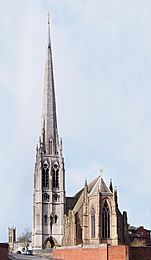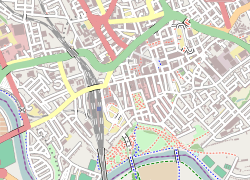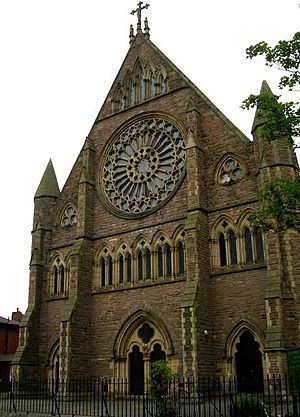Church of St Walburge, Preston facts for kids
Quick facts for kids St Walburge's Church |
|
|---|---|
| Catholic Church of St Walburge's, Preston | |

View from the east, along Pedder Street,
with St. Mark's in the distance |
|
| 53°45′46″N 2°42′54″W / 53.7629°N 2.7150°W | |
| OS grid reference | SD5296129851 |
| Location | Preston, Lancashire |
| Country | United Kingdom |
| Denomination | Roman Catholic |
| History | |
| Status | Active |
| Founded | 1847 |
| Dedication | Saint Walpurga |
| Consecrated | 3 August 1854 |
| Architecture | |
| Heritage designation | Grade I |
| Designated | 12 June 1950 |
| Architect(s) | J. A. Hansom |
| Style | Gothic Revival |
| Groundbreaking | May 1850 |
| Completed | 1873 |
| Specifications | |
| Length | 55 yards (50 m) |
| Width | 18 yards (16 m) |
| Spire height | 309 feet (94 m) |
| Materials | Sandstone body, slate roof Limestone steeple |
| Administration | |
| Deanery | Preston |
| Diocese | Lancaster |
| Province | Liverpool |
St Walburge's Church is a beautiful Catholic church located in Preston, England. It's famous for its incredibly tall spire, which is the tallest of any parish church in England! The church was designed by Joseph Hansom, a well-known architect from the 1800s. He also designed the hansom cab, a type of horse-drawn carriage.
St Walburge's is considered a very important building. It's listed as a Grade I building on the National Heritage List for England. This means it has special historical or architectural importance. In 2014, the church became a special place for prayer and devotion. It is now a shrine looked after by the Institute of Christ the King Sovereign Priest.
Contents
Who is Saint Walburga?
St Walburge's Church is named after Saint Walpurga. She was an English saint born around 710 AD. Her father was St Richard, a king from West Saxon.
Saint Walpurga traveled to Germany with her two brothers, St Willibald and St Winibald. They went there as missionaries to share their faith. Saint Walpurga was known for her amazing ability to heal people who were sick.
History of St Walburge's Church
St Walburge's Church is in an area of Preston called Maudlands. This name comes from "St Mary Magdalene". The church is close to where a hospital for people with leprosy once stood in the 12th century. That hospital was also dedicated to St Mary Magdalene.
Building the Church
In 1847, the Catholic faith was growing again in England. Preston was also doing well because of its textile mills. So, Joseph Hansom was asked to design a large new church.
Work on the church began in May 1850. It was ready for its first ceremony on August 3, 1854. The church was made even bigger in 1873. A new part was added at the back, with a tall window that is 35 feet (11 m) high.
Saving the Church
In 2007, St Walburge's and some other churches in Preston faced possible closure. People were very worried because of its beautiful architecture and its importance to the city.
The church was given seven more years, starting in August 2008. During this time, local people worked hard to raise money to restore the building. They also received grants to help.
David Garrard, an expert from the Victorian Society, said that St Walburge's is one of Preston's most important historic buildings. He explained it was built to show the pride of the Catholic community after they gained more religious freedom in the 1800s. He felt closing it would mean people would lose access to a rich part of Lancashire's history.
Becoming a Shrine
On April 4, 2014, Bishop Michael Campbell announced good news. He shared that the church would become a special shrine. This was agreed upon with Gilles Wach, who leads the Institute of Christ the King Sovereign Priest.
The Institute would help take care of the church. This would allow St Walburge's to be open every day as a shrine for prayer and devotion. The church would still be part of its local parish. It would also offer special traditional Catholic services.
The Shrine Church officially opened on September 27, 2014. Gilles Wach led a special Mass, with Bishop Campbell present. Mass is now celebrated daily at the Shrine. Other traditional services are also offered there.
Architecture and Special Features
St Walburge's is known for its amazing design. The architect used traditional Gothic styles in a very creative way. The Open Churches Trust calls it "an architectural gem of the North West of England."
The Tall Spire
The spire of St Walburge's Church is a huge landmark in Preston. It rises to 309 feet (94 m)! It's one of the tallest structures in Lancashire. Only Salisbury Cathedral and Norwich Cathedral have taller spires in the UK. It is the tallest spire on any parish church.
The spire is built from limestone blocks. These blocks were originally used for the nearby Preston and Longridge Railway. This gives the spire a reddish color when the sun sets.
In 2014, the church was shown on the BBC TV show Fred Dibnah's Magnificent Monuments. The famous steeplejack Fred Dibnah worked on the spire. He couldn't finish the job because of filming. His ladders were left at the church and later given to the worker who completed the task.
The Church Bell
The tower has one large bell. It weighs about 1.5 tonnes! This is the heaviest swinging bell in Lancashire. However, the bell is not rung often. This is because protected birds nest in the bell tower. So, it can only be rung during the winter months.
Sometimes, the spire is open for visitors to climb. You can book tickets online. The money from tickets helps support the church.
Outside the Church
The front of St Walburge's is made of New Red Sandstone. It has a very steep roof. The front is divided into two main parts by a horizontal archway. Strong buttresses and corner towers stick out. These are common features in many English Gothic cathedrals.
A large rose window dominates the upper part of the front. It is 22 feet (7 m) wide and takes up almost the entire width of the church.
Inside the Church
The inside of the church is very spacious. It can seat about 1,000 people. It is 165 feet (50 m) long and 55 feet (17 m) wide.
The open wooden roof is 83 feet (25 m) high. It is supported by fourteen large wooden beams called hammerbeams. At the end of each beam, there are life-sized carvings of saints.
The church also has a beautiful organ built in 1855. Other important features include a wooden triptych (a three-part artwork) and a crucifix. The crucifix has the shield of Preston and the motto "Princeps Pacis" (Prince of Peace). A statue of St. Ignatius of Loyola is also in the church. The patron saints of Great Britain are also shown inside.
Images for kids
See also
- Grade I listed churches in Lancashire
- Listed buildings in Preston, Lancashire
- List of tallest churches
- List of tallest structures built before the 20th century










